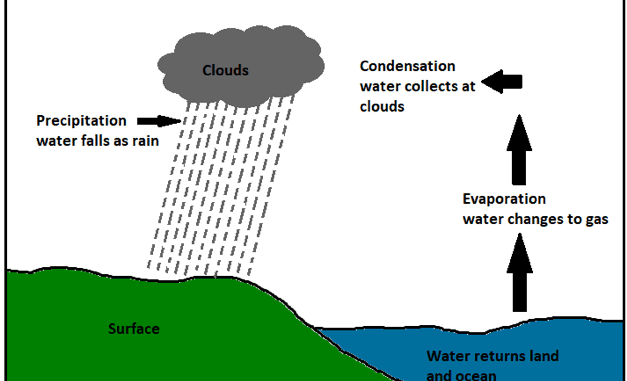
Introduction
There is a constant vaporization happening in our environment. Due to temperature, the vapors are constantly formed from the rivers, seawater, ponds, lakes, and land and mix with air. The amount of evaporation depends on the temperature of the air. The evaporation and vaporization capacity of warm air is high. Therefore, when the warm air cools down, the relative humidity of the air increases. And the water vapor in the air is condensed.
When water vapor condenses into water particles and snow particles, it falls to the ground in the form of rain, snowfall, hail, etc. under the influence of the earth’s gravitational force. These are known as different forms of precipitation. So the question as to what is precipitation in weather can be answered as precipitation is both liquid and solid. Liquid precipitation is rainfall and solid precipitation is snowfall and hail. Precipitation does not mean rain. Rainfall is a form of precipitation. When water vapor condenses and does not reach the surface, it is not called precipitation. That is why fog, frost, mist, etc. cannot be called precipitation (1) & (3).
Definition
When the water vapor in the atmosphere condenses into water particles and snow particles, it falls to the earth’s surface in the form of rain, snow, hail, etc. under the influence of the earth’s gravitational force. This natural phenomenon is called precipitation (1).
Causes of precipitation
The surface water is heated by the sun’s rays and turns into water vapor. As water vapor is lighter, it rises. This warm water vapor condenses in contact with the cool air in the upper atmosphere. And turned into tiny water particles. These tiny particles float to collect the dust in the air. These water particles gradually combine with each other and turn into larger water particles. Then these water particles can no longer float in the air. Due to the gravitational force of the earth, these particles fall as precipitation (rain, snowfall, hail, drizzle, etc.) on the earth’s surface (1) & (2).
Elements of precipitation
Precipitation is a natural process in which warm humid air rises, cools, and condenses. Falls to the ground in the form of rain, snowfall, etc. Two components are required for precipitation. These are
- Clouds full of water vapor
- Materials for cooling water vapor clouds (1).
Forms of precipitation
There are different forms of precipitation. The precipitation falls to the earth’s surface in both liquid and solid forms. It is discussed below.
1. Snowfall
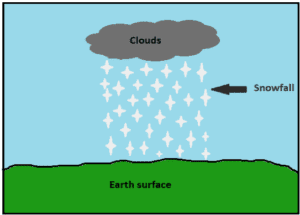
Fig: Snowfall
It occurs mainly in very low-temperature areas or in the mountains. In the cold temperature zone and the high mountain areas, clouds in the upper sky have very cold water particles, but these water particles do not participate directly in precipitation. Water vapor condenses around ice particles in cold clouds and turns into ice. As a result, the latent heat that is emitted often evaporates the water droplets. This makes the air drier. Eventually, the liquid water disappears and the ice gets larger. These are heavy so they cannot float in the air. And falls as snowfall due to the force of gravity on the surface (1).
2. Rain
The seawater evaporates and rises upwards. The water vapor flowing towards the land is obstructed and rises upwards. In both cases, the water vapor in the air under the influence of cold is converted into water particles by collecting dust and salt particles floating in the air.
Water particles come in contact with each other and turn into large water particles. These particles are so heavy that they cannot float in the air. So they fall to the ground in the form of rain (3).
Rainfall is divided into three main categories. These are
a. Convectional rainfall
b. Relief or orographic rainfall
c. Cyclonic rainfall
a. Convectional rainfall
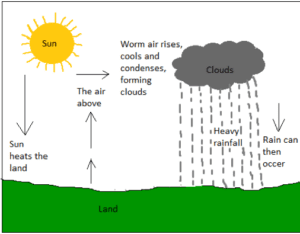
Fig: Convectional rainfall
In the equatorial and tropical regions, during the intense heat of the day, large amounts of water vapor are released into the air. As a result, light and humid air rises directly in the form of convection currents cools, and condenses into clouds. Rainfall occurs with thunderstorms near the surface of the ground. This is called convectional rainfall. In the equatorial regions, there is a convectional rainfall every afternoon (2).
b. Relief of orographic rainfall

Fig: Relief of orographic rainfall
When water vapor is interrupted by mountains, it rises, expands, and cools. As a result, the water vapor condenses and a lot of rain falls on the windward side of the mountain. This is called Relief or orographic rainfall. When the wind crosses the mountain and reaches the other side (leeward side) of the mountain, it has less water vapor. As it descends, it warms up and absorbs more water vapor. Due to this, there is very little rainfall on the leeward side of the mountain. This region is known as the rain shadow area (2).
c. Cyclonic rainfall
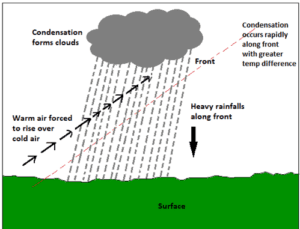
Fig: Cyclonic rainfall
The effect of a cyclone is that the water vapor cools and condenses into a transient drizzle or light rain for a few days. This is called cyclonic rainfall. There are two types of rainfall – temperate cyclones & tropical cyclones. In this type of rainfall, when two types of air meet each other, a frontal surface is formed at their junction (2).
3. Sleet or ice pellets
Ice pellets are a form of precipitation. Many times the lower layer of the atmosphere has a layer of cool clouds near the surface. The warm cloud layer is located above the cool cloud layer. Water droplets from warm clouds penetrate cold clouds and fall to the earth’s surface, congealing into small ice particles. This type of precipitation is called sleet or ice pellets. It is mainly found in countries of mid-latitude (1).
4. Drizzle
Fine water droplets with a circumference of fewer than 5 millimeters and falling very frequently to the ground are called drizzle. Drizzle falls to the surface from the stratus and strato-cumulus clouds (1).
5. Hail
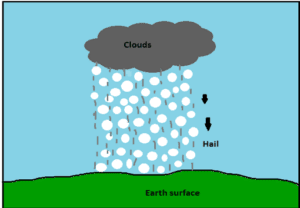
Fig: Hail
Small ice shots or ice cubes with a diameter of 5 to 50 millimeters or sometimes more fall to the ground with rain, called hail. When the winds of a strong storm go up, the water droplets rise too high, and the water droplets freeze in contact with extreme cold and turn into ice particles. As it descends through the cool air of water vapor, water vapor condenses around it, and the shape of ice particles increases. Hail is usually caused by cumulonimbus clouds (1) & (3).
6. Freezing rain
When a very cold water droplet falls, it crosses the air layer below the freezing point or falls on a similar cold surface and accumulates as a water droplet. This is called freezing rain (1) & (2).
7. Dew
When the temperature of the airdrops is below the dew point, some water vapor condenses in the air and accumulates on the surface of the grass or leaves of the tree. These water droplets are called dew. At night the surface cools as a result of heat radiation. As a result, the adjacent air layer cools and condenses near the surface. Dew is always the result of condensation in the clear cloudless sky in winter (1) & (2).
8. Frost
As the temperature drops below freezing, water vapor condenses to form frost. When the night temperature drops below freezing in the winter land or high mountain regions, dewdrops freeze and turn into solid ice. It is called frost. If the temperature drops below 0°c after the dew freezes, the dew freezes into solid ice that falls to the ground in the form of frost (1) & (2).
9. Rime
Rime is white ice crystals formed on objects that are at a temperature below the freezing point. For the rime, the temperature must be below 0°c. Any smooth surface, which is the windward side of the wind, is ideal for rime formation (1) & (2).
Written By: Manisha Bharati
More related article
